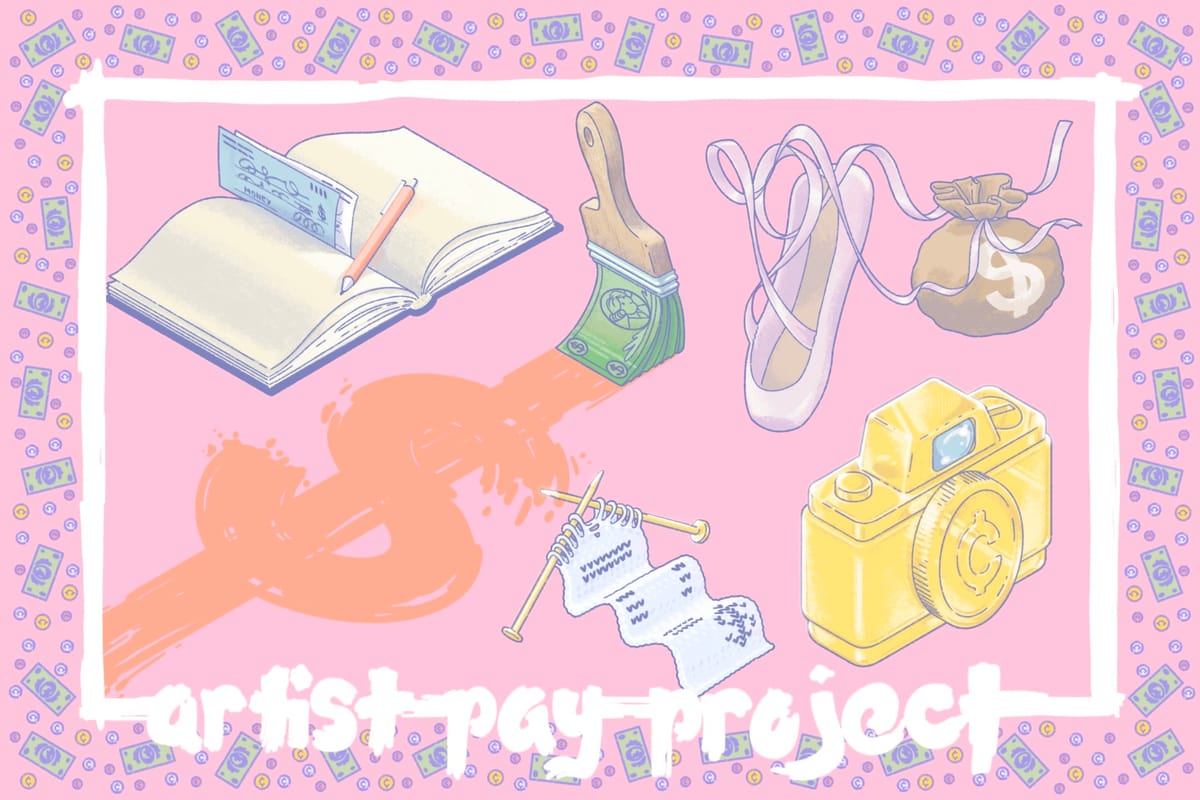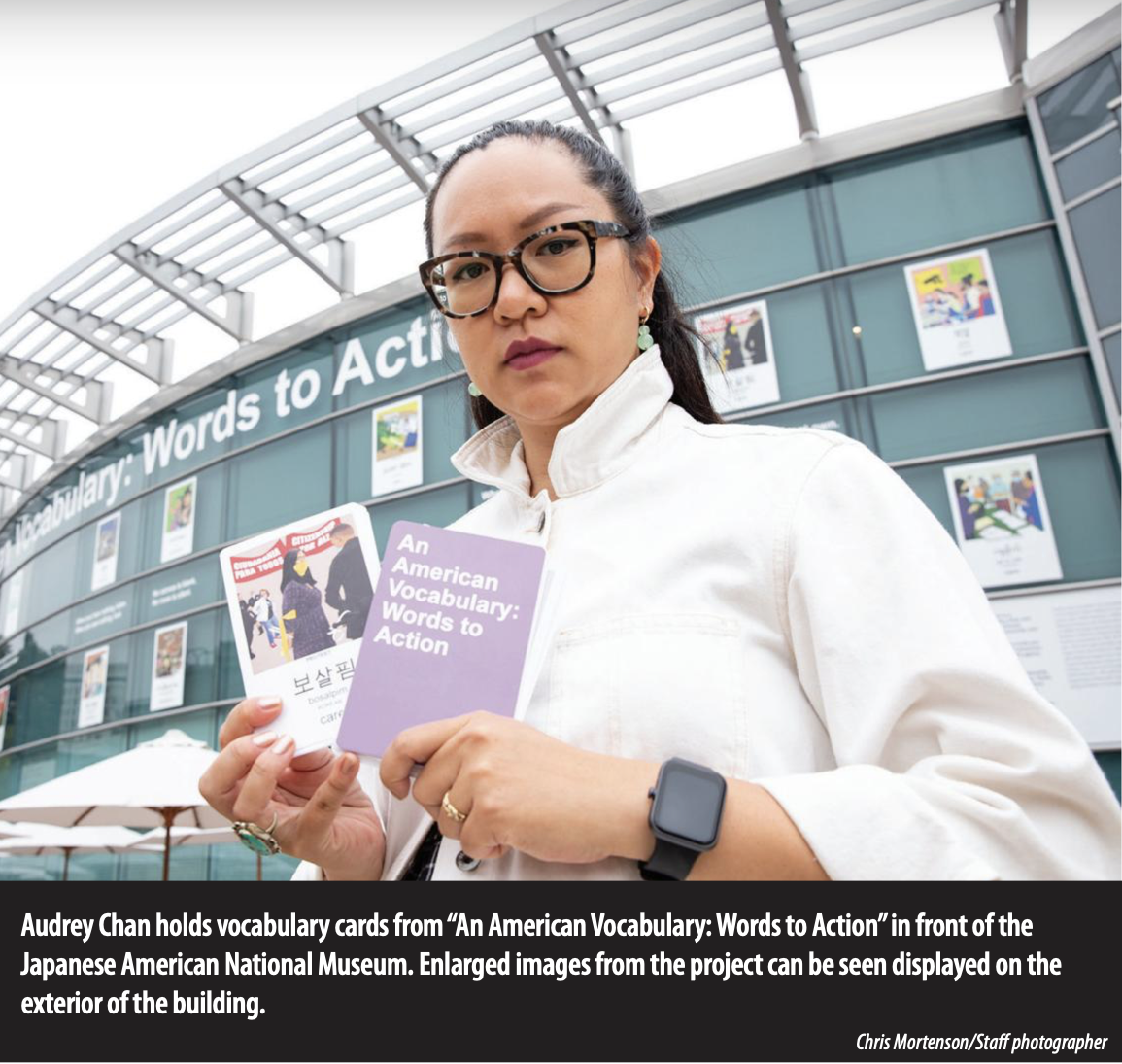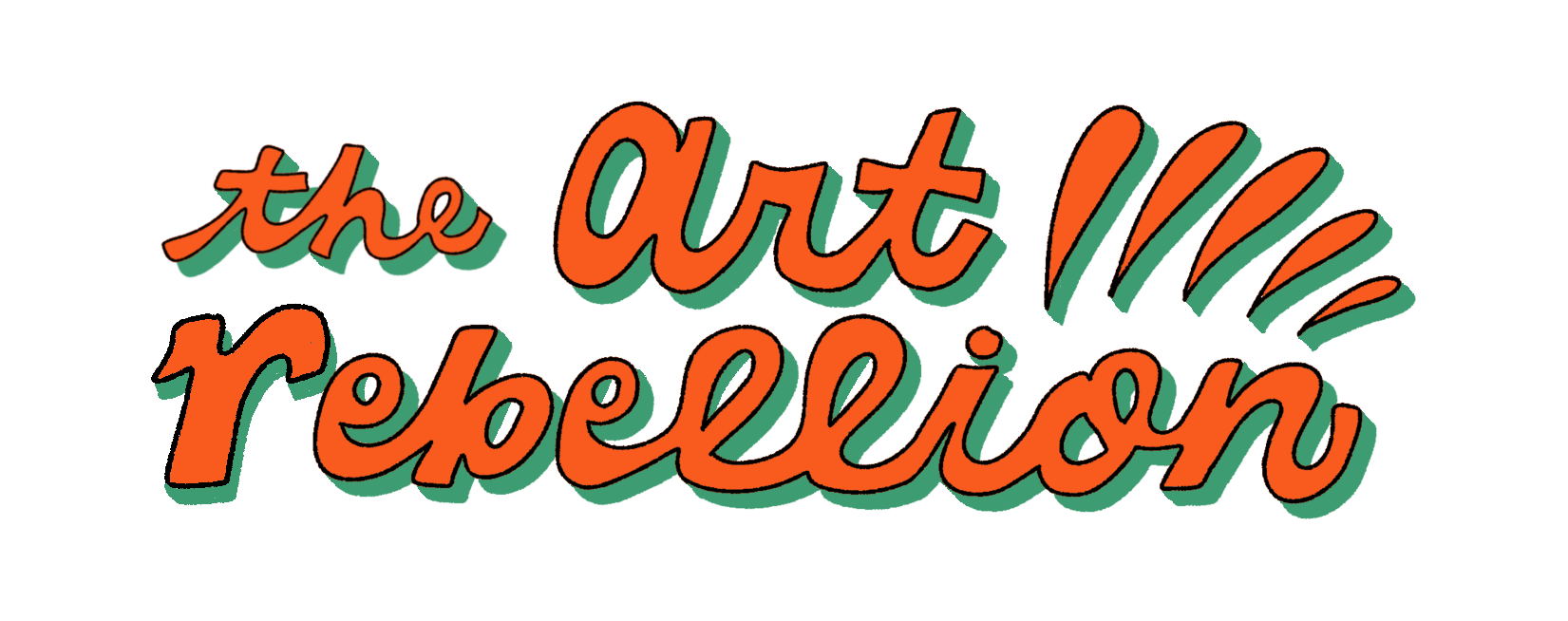Artist $napshot: Chicago based collage artist
Pursuing an MFA and BA left this artist with $100,000 of debt. He's actively avoiding paying it off for as long as he can.

The Artist Pay Project is a series exploring how artists in the U.S. survive and thrive amid a cost of living crisis.
This Artist $napshot tells the story of a 30-year-old collage and installation artist who makes between $2,500 and $3,000 monthly. This interview was conducted in October 2024.
Survey
Art Practice: Collage artist, designer, sculpture, installation artist
Location: Chicago, IL
Age: 30
Pronouns: He/Him
Earnings
Income:
Monthly income varies widely, but averages out to between $2,500 and $3,000 a month before taxes
How much of your income is from your art practice?
In 2024, it’s about 30% of my income
Where does the rest come from?
The rest of my income comes from a variety of freelance work that I do. Primarily, I do a lot of freelance photography, website design, video editing, etc. This past year I’ve made about $25,000 from this additional work
How much did you make from recent art-related gig work?
This also varies so widely. For instance, I just got a gig taking some photos for a small gallery for $125 but I also just did a huge shoot for a museum last month that paid $3,300. Another one of my recent clients was a dance academy in the suburbs that hired me to photograph one of their classes for promotional use and I was paid $260 for that.
How do you price your work?
I’ve sold work for anywhere between $200 and $1,500 per piece. Generally, I price things at the higher range of that the first time it’s shown (not including the gallery’s cut, so list price is often up to $2,000) and if things don’t sell at that price I’ll sell them at a discount and things often sell really quickly between $400 to $600 directly to collectors.
Expenses
Housing:
My wife and I split rent evenly at $1,445 so we each pay $722.50 per month.
What are your major monthly expenses?
- Credit card bills: I have a bunch of credit card debt, I pay about $350 a month towards that
- Car payment split with my wife: $125 per person, per month
- Cell phone bill: $100-ish because I’m paying off a new phone
- Health insurance through my wife’s work: $300 a month
Do you have any monthly expenses related to your art practice?
I pay $280 per month for studio rent. Material costs vary widely depending on the month and what I’m working on, but for example a recent piece sold for $500 and I probably spent $150 making it.
Larger financial picture
Do you have any financial support from outside sources?
My wife makes more money than me and has a steady job with consistent income so she often picks up slack on bills when there is some. Other than that, I don’t get much outside support apart from the occasional $100 bill from my grandma on my birthday.
Have you received any grants to support your art?
Yes, I received a $6,000 DCASE grant from the City of Chicago this past year.
Do you have health insurance?
Yes
Do you have any debt?
Yes, a mountain of student loan debt (roughly $100,000 from undergrad and grad school combined) that I’m not paying off and a smaller hill of credit card debt that I actually am paying off.
Do you have any savings?
Not a nickel!
Did you pursue higher education?
Yes I got my MFA and BA
Q&A
Responses edited for length and clarity.
How do you feel about your financial security right now?
It changes month to month because I'm doing freelance work. Some months are really good and some months, I really have to hustle a lot more to make ends meet. Having a partner, having a wife with a steady job and reliable income and benefits has made my life a lot more stable. I definitely think about money on a very regular basis, and wouldn't say that I'm living fully comfortably most of the time. Most months, I'm able to pay the bills, but it's almost always close.
That said, I am sustaining an art practice on top of the freelance work that I do. I'm doing something that requires money that isn't necessary for my survival. So I do have a luxury in the respect that I'm choosing to burden myself with, I guess. Generally, I feel better than I did a year ago. But still, things are uncertain, depending on how good the month is.
I’m curious if you thought about the financial side of things when you decided to pursue an MFA?
When I decided to pursue my MFA, I was working full time as a video editor. I had a steady job and I was making significantly more than I do now. Not a crazy amount — I was making like $50,000 a year at that point, and this was in 2020. I went through the process of applying to schools and interviewing. And decided to go to SAIC because I wanted to do something more creatively fulfilling. I had a creative job, and I still had a moment where I was like, do I really want to do this for the rest of my life?
Yes, maybe it would be somewhat financially stable, but am I just doing something that is not going to actually make me happy in the long run? I decided to try to pursue something that was a little bit more directly creative, or at least hone that craft so that I felt like I could engage in a practice, even if it's outside of what pays me at the end of the day. I didn't really go into it thinking that I was going to make a career out of being an artist, but more so that, I never really gave myself the opportunity to develop my practice, and I wanted to do that before settling down and putting that opportunity off the table.
My mindset was that I had a lot of marketable skills I had developed while I was working in this job, and that I could go back into being a freelancer or doing this kind of work that I had a lot of experience in if I needed to or wanted to. But I mean, as far as the debt that comes with going to grad school, I did have a certain level of debt nihilism about it, in that I knew I would be taking on this big burden, but I just embraced that that was the price of pursuing what I wanted to do. And that I would just have to figure out a way to make it work down the line.
I got accepted to SAIC in February of 2020, a month before covid happened. It ended up being the only thing that kept me afloat during covid, because I actually lost my job in June or July of 2020. It was a serendipitous thing that just I would have no way of knowing that I needed it at the time that it ended up happening.
With the ~$100,000 of debt that you have, is it something that's “out of sight, out of mind” for now, or does it ever worry you at all?
It is “out of sight out of mind,” because I'm on the income-based repayment plan. I'm not currently required to pay anything right now because the amount of money I made last year didn't reach the minimum that was required to continue making payments. I'm on top of it, as far as I'm not just letting it go into default or anything. But yeah, I'm actively avoiding paying it for as long as I can. I really don't know what is going to happen. Obviously, I'm going to have to start paying it at some point. The debt is something I think about from time to time, but honestly at this point, because the payments were not required for so long during covid, it's gone out of my mind so much that I don't really know what I would do if I absolutely had to start making significant payments. It's something that's looming in the background. And I’m avoiding it until I can’t.
That makes sense. How does living in Chicago impact you as a working artist?
I'm from Massachusetts originally. I lived there my whole life, until I moved to Chicago in 2021. Living in a big city was a huge adjustment, but I think it's really the only way that I'm able to do what I do, as far as freelance work, because so much of it relies on the network I have here. Initially, almost all of my freelance work after I moved here was documenting art exhibitions, and it was all word of mouth, and finding people who I knew, or were friends of friends, or people that I had random connections with. That was how I was able to build a photography portfolio. That has built into doing these bigger jobs for museums or galleries, and has made it a lot more sustainable over time, but I wouldn't have been able to get to that point if I didn't have this inside access to the art scene here in Chicago.
Even outside of freelance work, it's also what sustains my art practice. Having an art community where I can show art, and get feedback from people and also go to shows from my peers. From what I've seen, Chicago is a pretty unique, big city art scene in that way. It's not just the higher tier, blue chip galleries that you go to, or your friend's apartment. There's a lot in between that makes it feel a lot more vibrant and worthwhile. Just on a money level too, as far as selling art, that has given me a huge potential customer base for people that buy my work. Living here is one of the main reasons I'm able to live the way that I live and work in the way that I work.
Something that caught my attention in your survey was your breakdown of how much money it takes to complete a piece of art versus how much the piece sold for. You said it took $150 to make one work, which sold for $500. Is that breakdown — about 30% of your profits going to materials — common?
Pricing work varies a lot. For the piece I mentioned that sold for $500, usually, the first time it's shown, especially if it's at a commercial gallery, it could start at as high as $2,000. That’s because the gallery would take half, and I still want to get paid for my time and labor. If it doesn't sell there, then I will either sell it for just the amount that would have gone to me at the gallery, or significantly less than that, and work my way down to what the non-professional, collector customer base can afford. I don't necessarily think of pricing each piece in terms of how much material money that I've put into it. The ratio changes a lot. Usually, I think of it more in terms of how much time I put into a piece, rather than just the materials. Unless it was something really expensive.
As far as material cost, I want to at least break even and then pay myself for my time on top of that. If a piece hasn't sold for four years, sometimes I just want to break even — even on material costs, and just get it out of my studio. And so it really depends on how long I've had the piece, how long it's been out there, how many times I've shown it already, and all those things end up determining what the price is.
What kind of resources would be most helpful to you, from the city or nationally, to be able to live comfortably as an artist?
There are a lot of grants out there, but I think the issue for me is deciding which ones are worth applying to. There's such a process of going out and begging for money as an artist. I feel like I got lucky with the DCASE grant and it was this huge, singular chunk of money. It covered my studio rent costs for a year and a bunch of other stuff. Any way that artists can jump through fewer hoops in order to get grant money is helpful.
I don't know what would make my life easier, other than just having more money. If I was working a regular job, you could say — you should raise the minimum wage. But artists don't get a wage. There's not really a systemic-level solution that I see off the top of my head that can impact a lot of artists in the way that, other than UBI, or a subsidy for artists. But I don't know if that's society's highest priority right now.
I immediately thought about guaranteed income programs for artists. Springboard for the Arts in Minnesota as a guaranteed income program for artists. Another, called Artists at Work is a nationwide program that’s inspired by the Depression-era WPA, and it’s employing artists to work with community based organizations.
 the art rebellionMakeda Easter
the art rebellionMakeda Easter
Obviously, I would love that. But I feel like it would be so hard to get that enacted on a large scale, and I feel like there would be such a big backlash to the idea of just giving artists money. It would be beneficial to society, but knowing how our government tends to work, I feel like it would just be means-tested to death. Just making funding for actual working artists who really are invested in their practices and continually contribute to their community by putting on shows. Those people — and I feel like I'm part of that group — have so much unpaid labor. It's just a matter of finding ways to pay those people for their labor, because they're doing a service to the community. And oftentimes, even if work sells, a lot of successful artists who are selling work can't make a career out of that.
If you want art to exist and want artists to be able to really dedicate their lives, their practices, then it would be great to just give those people more money and not make them jump through all these hoops in order to get it, or play this lottery game of winning cash prizes in grants. When I’m in periods where I have been able to just completely spend all of my time making art, I feel like I'm contributing the most to society that I possibly can.
In some ways, I’ve resigned to that being an idyllic reality that isn't necessarily realistic. But any way that it can become more realistic is beneficial to society as a whole.
That's the ethos behind this project. Art and artists are essential and not extra or frivolous. However, it's not being recognized in that way and artists are suffering.
It is a matter of shifting people's mindsets. This is the example I think about a lot, which is very true in Chicago. The general public has been convinced that murals contribute to society. But I think beyond that, or beyond things that are in the Art Institute or the Museum of Contemporary Art, we're below the threshold of regular people understanding that that stuff is important and contributes significantly to the character of Chicago, the value of the city, and the history of the city. The current state of the Chicago art scene is historically significant and deserves to be treated as such.
On a certain level, it's a public opinion issue where people need to be convinced that art is intrinsically valuable, even if it's not their bag. But I don't know how one goes about convincing people of that.
Read more about the Artist Pay Project.
